
Marine angelfish are perciform fish of the family Pomacanthidae. They are found on shallow reefs in the tropical Atlantic, Indian, and mostly western Pacific Oceans. The family contains seven genera and about 86 species. They should not be confused with the freshwater angelfish, tropical cichlids of the Amazon Basin.
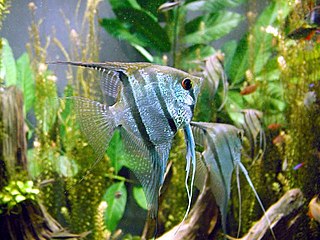
Pterophyllum is a small genus of freshwater fish from the family Cichlidae known to most aquarists as angelfish. All Pterophyllum species originate from the Amazon Basin, Orinoco Basin and various rivers in the Guiana Shield in tropical South America. The three species of Pterophyllum are unusually shaped for cichlids being greatly laterally compressed, with round bodies and elongated triangular dorsal and anal fins. This body shape allows them to hide among roots and plants, often on a vertical surface. Naturally occurring angelfish are frequently striped transversely, colouration which provides additional camouflage. Angelfish are ambush predators and prey on small fish and macroinvertebrates. All Pterophyllum species form monogamous pairs. Eggs are generally laid on a submerged log or a flattened leaf. As is the case for other cichlids, brood care is highly developed.
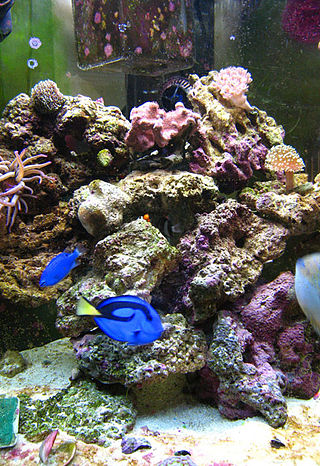
A marine aquarium is an aquarium that keeps marine plants and animals in a contained environment. Marine aquaria are further subdivided by hobbyists into fish only (FO), fish only with live rock (FOWLR), and reef aquaria. Fish only tanks often showcase large or aggressive marine fish species and generally rely on mechanical and chemical filtration. FOWLR and reef tanks use live rock, a material composed of coral skeletons harboring beneficial nitrogen waste metabolizing bacteria, as a means of more natural biological filtration.

The Maui Ocean Center is an aquarium and oceanography center located in Maalaea, Hawaii, on the island of Maui. Opened on March 13, 1998, by Coral World International, the 3 acres facility is the largest living tropical reef aquarium in the Western Hemisphere. Their exhibits include colorful displays of live coral reef habitats, diverse collections of endemic Hawaiian fish species, and up-close viewing of sea turtles, stingrays, sharks, and various sea creatures.
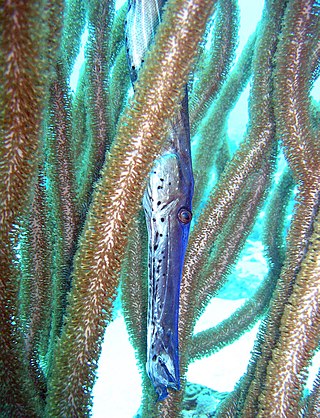
Aulostomus maculatus, the West Atlantic trumpetfish, is a long-bodied fish with an upturned mouth. It often swims vertically while trying to blend with vertical coral, such as sea rods, sea pens, and pipe sponges.

Holocentridae is a family of ray-finned fish, the only family of the suborder Holocentroidei within the order Beryciformes. The members of the subfamily Holocentrinae are typically known as squirrelfish, while the members of Myripristinae typically are known as soldierfish. In Hawaii, they are known by the Japanese name mempachi/menpachi (メンパチ) or the Hawaiian ʻūʻū.
Community aquaria are tanks that are designed to contain more than one species of fish. Most commonly they include a variety of species that do not normally occur together in nature, for example angelfish from Brazil, swordtails from Mexico, and gouramis from South East Asia. The aim of such communities is to bring together fish that are compatible in temperament and water requirements, while using their different colours and behaviors to add interest and entertainment value.

Sargocentron is a genus of squirrelfish found in tropical parts of the Indian, Pacific and Atlantic Oceans, with the greatest species diversity near reefs in the Indo-Pacific. Being largely or entirely nocturnal, they have relatively large eyes. Red and silvery colours dominate. The preopercle spines are venomous and can give painful wounds. Most have a maximum length of 15–25 cm (6–10 in), but S. iota barely reaches 8 cm (3 in), and S. spiniferum can reach more than 50 cm (20 in).
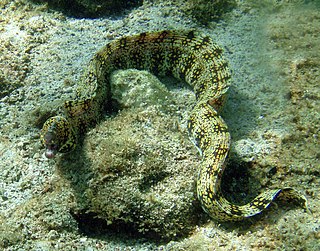
The snowflake moray, also known as the clouded moray among many vernacular names, is a species of marine eel of the family Muraenidae. It has blunt teeth ideal for its diet of crustaceans, a trait it shares with the zebra moray.

The snakeskin gourami is a species of gourami native to Southeast Asia. Prior to the merging of Belontidae to the family Osphronemidae, the snakeskin gourami was regarded as the largest member of its family. It is still the largest species in its genus and subfamily.

The spotted eagle ray is a cartilaginous fish of the eagle ray family, Aetobatidae. As traditionally recognized, it is found globally in tropical regions, including the Atlantic, Pacific and Indian Oceans. Recent authorities have restricted it to the Atlantic with other populations recognized as the ocellated eagle ray and Pacific white-spotted eagle ray. Spotted eagle rays are most commonly seen alone, but occasionally swim in groups. They are ovoviviparous, the female retaining the eggs then releasing the young as miniature versions of the parent.

Sargocentron xantherythrum, commonly known as Hawaiian squirrelfish or striped squirrelfish, is a member of the squirrelfish family. It is known from the Hawaiian Islands and Johnston Atoll. It is occasionally available in the aquarium trade. It grows to a total length of 17 centimeters (6.7 in).

The longspine squirrelfish is a silvery red, sea fish with orange-gold body stripes. One of about 150 species of squirrelfish, their most distinguishing characteristics are their large eyes and the long third spine of the anal fin. It is often included in public aquarium displays. The length of the longspine squirrelfish is about 18 cm. It lives in coral reefs in tropical and warm temperate seas and eats zoobenthos. It is territorial and uses sounds called "grunts" and "staccatos" to defend its crevice, warn of danger and, in groups, intimidate predators such as the moray eel. The longspine squirrelfish is edible and harvested on a small scale.

Sargocentron spiniferum, common name sabre squirrelfish, giant squirrelfish and spiny squirrelfish, is a large Indo-Pacific species of squirrelfish belonging to the family Holocentridae.

Sargocentron rubrum, also known as redcoat, is a member of the family Holocentridae of the order Beryciformes. Squirrelfish in general are large, active, nocturnal fish which are usually red in color.
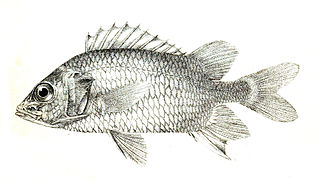
Sargocentron caudimaculatum, the silverspot squirrelfish or whitetail squirrelfish, is a reef-associated member of the family Holocentridae. It is native to the Indian and Pacific Oceans from East Africa to Japan and northern Australia and as far east as the Marshall Islands. It lives near reefs, but can also be found in lagoons and drop-offs at depths between 2 and 40 metres. It is a nocturnal predator, feeding primarily on crabs and shrimps. It can reach sizes of up to 25.0 centimetres (9.8 in) TL. Although it is caught commercially and can be found in the aquarium trade, there are no known major threats to this species.

Sargocentron microstoma, the fine-lined squirrelfish, slender squirrelfish or smallmouth squirrelfish, is a member of the family Holocentridae. It has a wide range throughout the Indo-Pacific from the Chagos Archipelago, Seychelles, and the Maldives to the Hawaiian Islands, Line Islands, and the Tuamotus Archipelago, north to the Ryukyu Islands and Bonin Islands, south to Austral Islands and throughout Micronesia. It lives near reefs usually at depths between 1–35 m (3.3–114.8 ft), but can be found as deep as 183 m (600 ft). During the day it hides in crevices, especially near Acropora and Pocillopora. It is a nocturnal predator, feeding on crustaceans, worms, and fishes. It can reach sizes of up to 20 cm (7.9 in) TL and has a venomous preopercle.
Sargocentron bullisi, more commonly known as the deepwater squirrelfish, is a nocturnal, reef-associated predator of the family Holocentridae. It is native to the West Atlantic from North Carolina, USA to southern Brazil and throughout the Caribbean Sea. It lives 33 to 110 metres below the surface. It can reach sizes of up to 13.0 centimetres (5.1 in) SL.

Sargocentron hastatum, the red soldierfish or the red squirrelfish is a species of marine fish of the family Holocentridae. It occurs in the eastern Atlantic, from the coasts of Portugal down to Angola, including Cape Verde.
Sargocentron poco, the saddle squirrelfish, is a species of squirrelfish belonging to the genus of Sargocentron. It is found in the Western Central Atlantic Ocean from the United States to the Cayman Islands, and in the Bahamas. It may also possibly be found in Cuba. It is likely to be more commonly found inhabiting shelf-edge reefs.

















